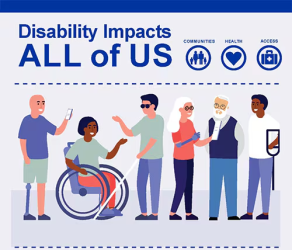
Disability. The World Health Organization (WHO) estimates that 1.3 billion people – about 16% of the global population – currently experience significant disability. This number is increasing due in part to population ageing and an increase in the prevalence of noncommunicable diseases.
Disability results from the interaction between individuals with a health condition, such as cerebral palsy, Down syndrome and depression, with personal and environmental factors including negative attitudes, inaccessible transportation and public buildings, and limited social support.
According to the World Health Organization, “Disability is part of being human.”
The U.S. Center for Disease Control (CDC) states: A disability is any condition of the body or mind (impairment) that makes it more difficult for the person with the condition to do certain activities (activity limitation) and interact with the world around them (participation restrictions).
There are many types of disabilities, such as those that affect a person’s:
- Vision
- Movement
- Thinking
- Remembering
- Learning
- Communicating
- Hearing
- Mental health
- Social relationships
Although “people with disabilities” sometimes refers to a single population, this is actually a diverse group of people with a wide range of needs. Two people with the same type of disability can be affected in very different ways. Some disabilities may be hidden or not easy to see.
According to the World Health Organization, disability has three dimensions:
- Impairment in a person’s body structure or function, or mental functioning; examples of impairments include loss of a limb, loss of vision or memory loss.
- Activity limitation, such as difficulty seeing, hearing, walking, or problem solving.
- Participation restrictions in normal daily activities, such as working, engaging in social and recreational activities, and obtaining health care and preventive services.
Disability can be:
Progressive (for example, muscular dystrophy), static (for example, limb loss), or intermittent (for example, some forms of multiple sclerosis).
Related to conditions that are present at birth and may affect functions later in life, including cognition (memory, learning, and understanding), mobility (moving around in the environment), vision, hearing, behavior, and other areas.
These conditions may be
- Disorders in single genes (for example, Duchenne muscular dystrophy);
- Disorders of chromosomes (for example, Down syndrome); and
- The result of the mother’s exposure during pregnancy to infections (for example, rubella) or substances, such as alcohol or cigarettes.
- Associated with developmental conditions that become apparent during childhood (for example, autism spectrum disorder and attention-deficit/hyperactivity disorder or ADHD)
- Related to an injury (for example, traumatic brain injury or spinal cord injury).
- Associated with a longstanding condition (for example, diabetes), which can cause a disability such as vision loss, nerve damage, or limb loss.
A person’s environment has a huge effect on the experience and extent of disability. Inaccessible environments create barriers that often hinder the full and effective participation of persons with disabilities in society on an equal basis with others. Progress on improving social participation can be made by addressing these barriers and facilitating persons with disabilities in their day to day lives.